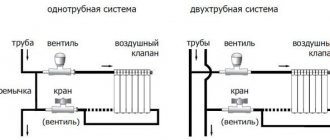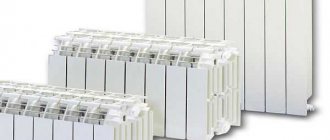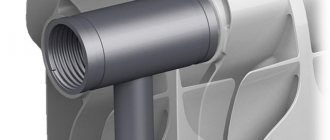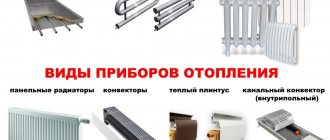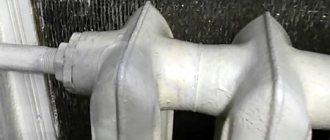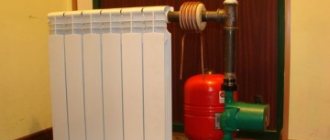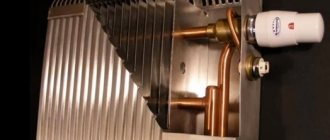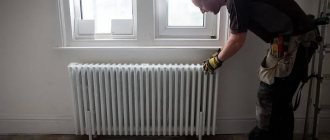Application area and radiator groups
Horizontal version of a narrow heating radiator
Narrow-format heating radiators are considered alternative for use in different cases. This may be due to the availability of free space and design features. Such radiators are divided into horizontal and vertical.
Features of narrow horizontal batteries
Horizontal options are often used for heating narrow rooms with low walls or partitions or panoramic windows. The narrow horizontal design is suitable for loggias and balconies. This option is optimal for long rooms and corridors.
Narrow vertical models
Vertical heaters are installed on small but high partitions. Also mounted on temporary or load-bearing walls. Models of non-standard types are installed on special brackets and have an unusual shape. Such heater options are most often selected for individual design.
It is not always possible to fit standard products into a modern interior. Therefore, they try to purchase models that simultaneously solve technical and artistic problems.
How to choose the right narrow radiators
Table for selecting a heating radiator by thermal power
When choosing narrow heating structures for installation at home, you must be guided by various factors. If you ignore them, you may encounter problems with improper functioning of the structure.
- Pressure of the general heating system.
- Coolant quality and type.
- Coolant operating temperature range.
- Carrying out annual hydraulic audits.
It is worth considering the material of the radiators. Home owners often make the mistake of choosing aluminum structures. They are very demanding about the purity of water, so they can quickly fail. For water or steam coolant, it is better to use such elements provided that a special system cleaning filter is installed.
Criterias of choice
Water systems are more difficult to work with; several additional factors may influence the purchasing decision, in addition to the dimensions and material from which the body, fins and pipes are made.
Low heating radiators
Assortment of standard sizes of aluminum batteries
Low variants of heating structures are made of different materials: steel, aluminum, cast iron and other alloys. Be sure to pay attention to this when choosing a model.
Aluminum structures
They are distinguished by their relatively small weight, so they do not require special training before installation and the involvement of a team of builders. The models are small in size, but have a high degree of heat transfer.
Steel
Most often they are produced in the form of tubular heating elements. Suitable for arranging heating in small-height walls. The approximate size of the partition for low tubular batteries is about 180 mm.
Bimetallic options
This type is suitable for organizing heating in rooms with panoramic windows. The bimetallic construction is characterized by high performance. Excellent contact with other materials. This ability is necessary when connecting the heater with other elements of the heating system.
Cast iron options are most often installed in rooms where there is minimal wall insulation. Such structures have good heat transfer, but are quite heavy and are not suitable for installation in new buildings.
Basic materials used for production
Currently, the main criterion that separates all low radiator models available on the market is the material from which they are made. Along with the traditional ones used in the last century, new types are appearing with better performance properties.
Cast iron radiators
Elements made of cast iron have the longest history of use. They are distinguished by high heat transfer, long cooling and heating, large mass and their low resistance to shock loads.
The increased roughness of the inner surface of the cast sections of a cast iron battery contributes to the accumulation of dirt and rust deposits on its walls, which over time significantly reduces heat transfer.
Note! Despite the fluidity of cast iron, the manufacturer produces heat exchangers with a height of at least 390 mm. This is due to the disadvantages mentioned above
There are batteries made at a sufficient artistic level, which allows you to decorate the interior of rooms.
This is a decoration you can install at home
Steel heat exchangers
Products made from this iron-carbon alloy can be smaller in size than cast iron. They are a plate structure, the basis of which is metal pipelines. This aspect significantly reduces the required amount of coolant in the system and, as a result, increases its efficiency.
In the photo - steel panel batteries
Heat exchangers made from steel have a number of positive and negative aspects. Their weight is significantly lower than cast iron, they are more compact and have greater heat transfer. Disadvantages include susceptibility to corrosion and poor resistance to water hammer.
Steel heating radiators are low in height and have poor repairability. If one of the sections of a cast iron battery is damaged, it is easy to replace or eliminate it.
The steel product will have to be replaced entirely, which will lead to additional costs. The price of such units is one of the most significant in the segment.
Aluminum radiators
Low aluminum heating radiators have a range of advantages over their competitors.
- minimum weight of all similar products;
- good heat dissipation;
- and the plasticity of the metal allows you to obtain products of elegant shapes.
The size of the devices does not affect their characteristics
Note! Aluminum does not have great strength characteristics, which can lead to the formation of leaks due to water hammer in the system that occurs when it is filled or drained. The average service life of such products does not exceed 12-15 years
The cost of radiators made of aluminum is low.
Bimetallic batteries
One of the latest types of heating devices recommended for use in individual heating systems of private houses are the so-called bimetallic batteries. They are made on the basis of steel or copper pipelines equipped with aluminum plates.
Reliable strength of two metals in bimetallic devices
Their advantages include the following:
- sufficient corrosion resistance;
- significant (up to 100 atm.) operating pressure that they can withstand;
- low volume of coolant required for heating.
Such designs also have disadvantages:
- less heat transfer compared to aluminum products;
- the highest cost among all low radiators.
Panel heating systems
If you decide to get a heating system for your home that is completely devoid of visible elements, panel heaters can come to the rescue. These are really low horizontal heating radiators. Their height from the floor does not exceed 20 cm with a thickness of 30 mm.
Such products are located along the walls and covered with decorative overlays (panels). Using this option, you can get a heating system with a height of 100 mm, operating like a standard one with high radiators. The significant disadvantages of this heating option are the high cost and complete unsuitability for repair.
Features of operation
It is recommended to use steel radiators when organizing private heating.
Radiators made of steel or aluminum are not always suitable for use. Aluminum is not compatible with copper elements, which are often used for plugs or as connectors and taps. The presence of large amounts of oxygen is unacceptable for steel, since under its influence it begins to quickly rust.
Batteries made from these materials can be used in apartments if all operating requirements are met. It is equally important to take into account that it is rational to install radiators made of light and thin alloys when organizing individual heating.
Narrow radiators with a large height must be equipped with an air duct. It is installed opposite the pipeline in the upper manifold. To simplify operation, it is better to choose automatic mechanisms.
Built-in devices
Heating radiators built into the floor are used to heat office, retail and residential establishments. They can be used in greenhouses and conservatories to create temperature conditions that are comfortable for plants. The operation of the device is based on the principle of convection. Built-in units promote intensive air circulation, so they heat the room faster and more efficiently, which reduces heating costs.
Worth knowing! There are built-in radiators on sale with automatic temperature control, condensate removal function, and the ability to program the microclimate in the room.
The unit has a simple design. Inside the metal housing there is a heat exchanger with convective plates. The body of the device is built into the floor, and is covered with a durable decorative grille on top.
Advantages and disadvantages of narrow radiators
Narrow radiators have good heat transfer
Narrow radiators have the following advantages:
- Suitable for universal use. Such structures can be installed near a wall, under a window or anywhere else in the room. Many of them have an aesthetic appearance.
- Good heat dissipation. This parameter corresponds to a greater extent to vertical radiators. They heat the air simultaneously in the upper and lower parts of the room.
- Good quality. Narrow radiators are reliable and tight. All joints are made with perfect, durable seams. The approximate service life of the radiator is 10-15 years.
- Suitable for heating rooms with non-standard shape and area. For the space under the stairs or the cellar, such a heater will be very useful, as it will easily fit into the room.
The disadvantage of these types of radiators is their high cost.
Disadvantages of this equipment:
- Installation under a window is not always possible. This is not only the most convenient area, but also quite functional. There is fairly effective air circulation here.
- High price. Instead of one narrow battery, you can buy two or three ordinary ones. It all depends on the size and power of each. However, narrow options heat the room better.
- The small radiator needs flushing. It is best to do this twice a year: before starting and turning off the heating. Some complex structures tend to become clogged, resulting in air pockets.
The efficiency of heating narrow heating radiators depends on the correct choice of the device and its advantages, as well as some installation features.
Specifics of floor batteries
Low radiators are installed under panoramic windows.
Floor radiators replace conventional ones if you want to open the space without masking the facade. A center-to-center distance of 20 cm will emphasize the panoramic type of glazing. The devices are connected to the main line using a floor or side method, depending on the pipe outlet. To control the intensity of heating and temperature conditions, rooms can be equipped with thermostat valves and taps.
In combination with panoramic windows, the heaters look beautiful and neat. Thermal output depends on the number of sections and is comparable to standard ones with a center distance of 0.35 m.
Operating principle
As a component of a water heating system, floor-standing units function as follows:
- Heating the coolant in the boiler room to the required temperature.
- Supplying water through pipes and filling batteries.
- Heating of the case.
- The supply of thermal energy to a room through radiation or convection.
Only panel and sectional batteries operate according to the radiation principle, which consumes up to 80% of the total power. Heat waves are directed perpendicularly or in two directions at an angle.
Models with a ribbed tube radiator transfer heat using the principle of convection. Heated air moves in the room towards the ceiling and displaces cold air.
Dimensions of high narrow and low convectors
Standard heating radiators have the following parameters: length - 93 mm, depth 140 mm, height 388 mm. Such structures have good heat transfer if they are made of thin alloys. If this is a cast iron option, the power of one section will be 106 watts.
Designs that are used for heating small spaces (tall radiators) have the following dimensions: width 76 mm, height 661-954 mm, depth 203 mm. The operating pressure of such a heater is 10 atmospheres.
Tips for installing narrow radiators
The minimum gap between the wall and the battery must be at least 5 cm.
When installing batteries under a window or on a solid wall, some nuances must be observed.
- If installation of the structure under the window is unavoidable, you must initially find the center of the window sill along which to measure the radiator axis.
- Consider air convection. Maintain a gap between the wall and the battery. The minimum gap should be 5 cm.
- If radiators with an air cut-off are installed, they must be located at a distance of at least 5 cm.
- When installing low radiators on the wall, it is necessary to take into account that the distance from the radiator should be at least 3 cm, and from the floor - 5-10 cm.
- To maintain an attractive design in the room, you can place the radiator in a pre-prepared niche. Communications should be made to her in advance.
It is necessary to install radiators along each wall facing the outside. This significantly improves the indoor microclimate.
Narrow horizontal and vertical radiators are considered quite popular among users who own country houses. In such homes, heaters always pay off, creating warmth and comfort at normal energy costs.

